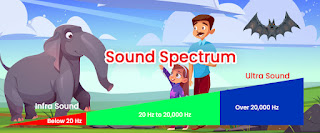Ultrasonic waves and Infrasonic waves soundCBSE Class 8 Science
Infrasonic sound is defined as a sound with a frequency of less than 20 Hz. The frequency of infrasonic sounds is below the range of human hearing ability.
Infrasonic sound waves can be produced by earthquakes, thunder, and volcanic eruptions, for example. Elephants and whales can detect this sound, even if the human ear is incapable of hearing it. Elephants, whales, rhinos, and pigeons all use infrasound to communicate.
What are Waves of ultrasonic sound?
Ultrasonic sound is defined as sounds with a frequency of more than 20,000 hertz (cycles per second). The frequency of ultrasonic noises is higher beyond the range of human hearing ability to discriminate.
The hearing range of dogs, cats, bats, and mice, for example, extends into the ultrasonic frequency region. They are able to detect wavelengths that humans are unable to detect.
Ultrasound's Applications
- Ultrasound is also used to monitor a baby's development in the womb at various stages.
- Ultrasound is used to weld plastic surfaces.
- Echocardiography is the use of ultrasound to explore the structure and motion of the heart. The information is used to see if the patient's heart has a problem.
Know more about the Characteristics of sound waves
Click for Online tuition for class 8

Comments
Post a Comment
Thank you we will contact ASAP.